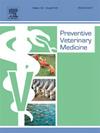生物安全投资对美国商业火鸡业务中高致病性禽流感控制的影响
IF 2.4
2区 农林科学
Q1 VETERINARY SCIENCES
引用次数: 0
摘要
高致病性禽流感(HPAI)是一种极具传染性的病毒,通过候鸟传染对美国火鸡产业构成重大威胁,并导致整个农场人口减少。为了对抗高致病性禽流感的灾难性经济影响,本研究考察了生物安全投资如何为生产者和行业带来经济利益。利用对商业火鸡生产商进行的以农场为重点的调查收集的数据,分析了2022年受高致病性禽流感影响的农场与未受影响的农场之间生物安全做法的差异。该评估旨在了解生物安全投资在降低火鸡养殖场对高致病性禽流感的易感性方面的有效性,以及哪种类型的养殖场更有可能进行这类投资。与感染几率较低相关的因素包括饲养母鸡,自2015年以来对农场进行临时生物安全投资,如临时减少野鸟数量,以及进行特定的永久性生物安全投资,如改善饲料箱、洗车站和谷仓通风系统。此外,那些饲养母鸡的农场,那些参加了NPIP的农场,以及那些在火鸡饲养场周围没有牲畜通道的农场,更有可能进行生物安全投资。这些发现有助于为生产者、整合者和公共政策提供信息,说明如何减少高致病性禽流感的传播,从而使家禽业的经济和寿命都受益。本文章由计算机程序翻译,如有差异,请以英文原文为准。
Biosecurity investment impacts on highly pathogenic avian influenza control in United States commercial turkey operations
Highly pathogenic avian influenza (HPAI) is an extremely transmissible virus that poses a significant threat to the U.S. turkey industry through contagion from migratory birds and results in whole-farm depopulation. To combat the disastrous economic impacts of HPAI, this study examined how biosecurity investments may have economic benefits to producers and the industry. Using data collected from a farm-focused survey of commercial turkey producers, the differences in biosecurity practices between farms affected by HPAI and unaffected farms in 2022 were analyzed. This evaluation aims to understand how effective biosecurity investments were towards reducing the susceptibility of a turkey farm to HPAI and what types of farms were more likely to make those types of investments. Factors associated with lower chances of being infected included having any hens, making any temporary biosecurity investments to the farm since 2015 such as temporary wild bird mitigation, and making specific permanent biosecurity investments such as improving feed bins, vehicle wash stations, and barn ventilation systems. Also, those farms that raised any hens, those that participated in the NPIP, and those without livestock access around turkey barns were more likely to make biosecurity investments. These findings aid in informing producers, integrators, and public policy on how to reduce the spread of HPAI to benefit both the economy and longevity of the poultry industry.
求助全文
通过发布文献求助,成功后即可免费获取论文全文。
去求助
来源期刊

Preventive veterinary medicine
农林科学-兽医学
CiteScore
5.60
自引率
7.70%
发文量
184
审稿时长
3 months
期刊介绍:
Preventive Veterinary Medicine is one of the leading international resources for scientific reports on animal health programs and preventive veterinary medicine. The journal follows the guidelines for standardizing and strengthening the reporting of biomedical research which are available from the CONSORT, MOOSE, PRISMA, REFLECT, STARD, and STROBE statements. The journal focuses on:
Epidemiology of health events relevant to domestic and wild animals;
Economic impacts of epidemic and endemic animal and zoonotic diseases;
Latest methods and approaches in veterinary epidemiology;
Disease and infection control or eradication measures;
The "One Health" concept and the relationships between veterinary medicine, human health, animal-production systems, and the environment;
Development of new techniques in surveillance systems and diagnosis;
Evaluation and control of diseases in animal populations.
 求助内容:
求助内容: 应助结果提醒方式:
应助结果提醒方式:


